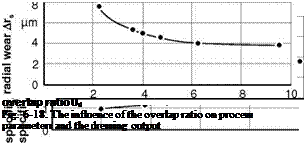The topography of the grinding wheel after tool preparation largely influences its cutting properties and thus its behaviour during the process as well as the output. By means of a precise guidance of tool preparation, the grinding wheel surface can be adjusted to the given requirements. For example, producing a rough topography is always recommendable when high cutting forces or an influence of temperature on the workpiece surface layer are to be expected, the cutting edge surface must exhibit a large chip space volume and there are no high demands placed on the surface quality of the workpiece.
The decisive parameters are the dressing overlap ratio Ud, the depth of dressing cut aed or the dressing feed frd and the dressing speed ratio qd, which however is only a factor for rotating dressing tools.
6.1.5.1 The Dressing Overlap Ratio Ud
The dressing overlap ratio Ud is calculated for an axial movement of the dressing tool and indicates how closely the grooves created by the dressing tool on the grinding wheel surface adjoin each other (Fig. 6-16). In the case of larger overlap ratios, a smaller effective surface roughness is formed on the grinding wheel.
Influence on the Grinding Process
The influence of the overlap ratio on grinding forces, radial wear of the grinding wheel and surface roughness of the workpiece is represented in Fig. 6-18. After a dressing process with high overlap ratios, the grinding wheel exhibits a low effective surface roughness with a large number of grits and little grain protrusion. In the grinding process, an equal amount of material is removed by a larger number of momentary cutting edges in smaller chips.
In the case of higher dressing overlap ratios, grinding forces are determined by two opposing effects. Lower individual chip thicknesses lead to lower cutting forces at each cutting edge. Because of increased friction and the larger number of cutting edges, the particular forces add up to a larger total grinding force.
|
grinding wheel A 60 K — 8 V workpiece material Ck 45 N dressing parameters dressing plate aed = 30 pm effective profile: -ІЇ a*d 105 pm 25 pm grinding parameters Q’w = 1 mm3/mms V’w= 400 mm3/mm vc= 45 m/s q= 60 ta= 10 s |
 |
It is not the amount of total cutting forces which is decisive for grinding wheel wear, but the stress and stability of each cutting edge. For this reason, the radial wear of a crudely dressed wheel is larger in spite of a lower total cutting force value. This is due to the higher engagement forces at the individual grain.
The large cutting edge numbers created by a high overlap ratio and the low effective surface roughness of the grinding wheel have a positive effect on the average surface roughness of the workpiece. The reason for this is that material removal is distributed across a larger amount of active cutting edges at otherwise constant conditions.
The typical progression of the relations represented in Fig. 6-18 leads to the conclusion that there is a maximum overlap ratio which is sensible. An increase beyond this value does not change the surface quality of the workpiece, but it does increase the dressing time unnecessarily. This maximum practical overlap ratio depends on the respective grinding wheel specifications.
All dressing tools wear as a function of the respective settings, the dressed grinding wheel volume, the grinding wheel specifications and the wear resistance
of the dressing tool itself. The effective width alteration of a dressing tool as a function of the dressing volume is shown in Fig. 6-19.
After a heavy increase in wear of the monocrystalline diamond, which is very sharp when new, its effective width grows constantly with increasing engagement time. This leads by necessity to a change in the overlap ratio and thus to altered grinding wheel process behaviour. For a constant dressing output, the dressing overlap ratio must remain unchanged.
In the case of multi-edged dressing plates and multi-grain dressers, more or less heavily fluctuating effective width behaviour can manifest itself. The cause for such erratic change in effective dressing width is the breakaway of individual diamond grains or needles from the dresser. However, by an appropriate design of the diamond specification and pattern, this effect can be successfully countered.
